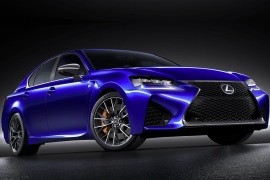LEXUS GS F Models/Series Timeline, Specifications & Photos
First production year: 2015
Engines: Gasoline
For decades, the GS was often criticized for its lack of sporty driving behavior, and not even the fourth generation launched in 2012 could fully achieve that, and then, the GS-F broke covers.
Lexus released the F version of the GS at the 2015 North American International Auto Show as a top-performing version of the Japanese luxury mid-size sedan. The automaker said the new version was 80% sports car and 20% luxury vehicle. While that might sound like a stretch, the specifications backed up its statement. Furthermore, the overall look of the GS-F plus the naturally aspirated V8 engine under the hood was part of the package that transformed the otherwise luxurious vehicle into a top performer. Unlike its main competitors made by BMW or Mercedes-Benz, the Japanese sports sedan didn't use any sort of supercharging methods and had an RWD drivetrain.
Sporting a distinctive front fascia, the 2015 GS-F featured a broader spindle grille, part of the automaker's design language. It was flanked by angular-shaped headlights, which in turn were underlined by V-shaped, arrow-like daytime running lights that pointed toward the car's center. The apron sported a pair of side scoops adorned by a diamond-shaped mesh, identical to the one from the main grille.
The car's profile looked distinct from the rest of the GS range. Its front fenders were wider and featured an oblique, raked-forward exhaust vent. It also sported an F-letter badge specific to Lexus's high-performance models. A unique set of aerodynamic side sills emphasized the car's sporty character, while the standard 19-inch alloy wheels wrapped in 255/35 tires up front and 275/35 in the rear. Out back, the car manufacturer added a lip spoiler on the deck, while the rear bumper featured an underbody diffuser flanked by stacked twin exhausts.
Inside, the luxurious cabin of the GS has been replaced by the sport-oriented cabin of its sibling with the F badge. The front occupants sat on high-bolstered seats featuring multiple adjustments. There were no wood trims on the dash, door cards, and center console. The automaker placed carbon fiber trims to emphasize the vehicle's sporty character. Behind the F-badged steering, Lexus installed paddle shifters for the automatic transmission, while the instrument panel that fronted it sported digital displays that looked different depending on the driving modes. These could be changed from a rotary dial housed by the center console and varied from ECO to Sport+. In the back, the bench seat was profiled for two, albeit it featured three headrests and seat belts, suggesting it was suitable for three occupants.
However, customers looking for a performance mid-size sedan were more interested in what was under the GS-F's skin. Up front was a five-liter V8 engine that produced 473 PS (467 hp) and an impressive 527 Nm (389 lbs.-ft) of torque. It could run in the Atkinson cycle to optimize fuel efficiency when cruising or the Otto cycle when the skinny pedal was mated to the floormats. The eight-speed automatic transmission could change quicker or more smoothly, depending on the driving modes. It also included a manual mode where the driver could use the paddle shifters behind the steering wheel to keep the car in the desired rev range. At the back, Lexus's Torque Vectoring Differential, which debuted on the RC-F model, was standard and could work in three different modes, depending on the driver's needs: for regular driving, for a winding road, or for track use.
